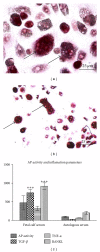Monocytes do not transdifferentiate into proper osteoblasts
- PMID: 22623892
- PMCID: PMC3353470
- DOI: 10.1100/2012/384936
Monocytes do not transdifferentiate into proper osteoblasts
Abstract
Recent publications suggested that monocytes might be an attractive cell type to transdifferentiate into various cellular phenotypes. Aim was, therefore, to evaluate the potential of blood monocytes to transdifferentiate into osteoblasts. Monocytes isolated from peripheral blood were subjected to two previously published treatments to obtain unique, multipotent cell fractions, named programmable cells of monocytic origin (PCMOs) and monocyte-derived mesenchymal progenitor cells (MOMPs). Subsequently, MOMPs and PCMOs were treated with osteogenic differentiation medium (including either vitamin D or dexamethasone) for 14 days. Regarding a variety of surface markers, no differences between MOMPs, PCMOs, and primary monocytes could be detected. The treatment with osteogenic medium neither resulted in loss of hematopoietic markers nor in adoption of mesenchymal phenotype in all cell types. No significant effect was observed regarding the expression of osteogenic transcription factors, bone-related genes, or production of mineralized matrix. Osteogenic medium resulted in activation of monocytes and appearance of osteoclasts. In conclusion, none of the investigated monocyte cell types showed any transdifferentiation characteristics under the tested circumstances. Based on our data, we rather see an activation and maturation of monocytes towards macrophages and osteoclasts.
Figures





Similar articles
-
Programmable cells of monocytic origin as a source of osteochondroprogenitors: Effect of growth factors on osteogenic differentiation.J Craniomaxillofac Surg. 2017 Sep;45(9):1515-1520. doi: 10.1016/j.jcms.2017.05.026. Epub 2017 Jun 4. J Craniomaxillofac Surg. 2017. PMID: 28688862
-
Human circulating CD14+ monocytes as a source of progenitors that exhibit mesenchymal cell differentiation.J Leukoc Biol. 2003 Nov;74(5):833-45. doi: 10.1189/jlb.0403170. Epub 2003 Jul 22. J Leukoc Biol. 2003. PMID: 12960274
-
Effect of monocytes/macrophages on the early osteogenic differentiation of hBMSCs.J Tissue Eng Regen Med. 2013 May;7(5):392-400. doi: 10.1002/term.535. Epub 2012 Mar 6. J Tissue Eng Regen Med. 2013. PMID: 22392849
-
Alkaline phosphatase expression during monocyte differentiation. Overlapping markers as a link between monocytic cells, dendritic cells, osteoclasts and osteoblasts.Immunobiology. 2000 May;202(1):68-81. doi: 10.1016/S0171-2985(00)80054-6. Immunobiology. 2000. PMID: 10879691
-
Crosstalk of osteoblast and osteoclast precursors on mineralized collagen--towards an in vitro model for bone remodeling.J Biomed Mater Res A. 2010 Dec 1;95(3):848-56. doi: 10.1002/jbm.a.32856. J Biomed Mater Res A. 2010. PMID: 20824694
Cited by
-
Co-Culture with Human Osteoblasts and Exposure to Extremely Low Frequency Pulsed Electromagnetic Fields Improve Osteogenic Differentiation of Human Adipose-Derived Mesenchymal Stem Cells.Int J Mol Sci. 2018 Mar 27;19(4):994. doi: 10.3390/ijms19040994. Int J Mol Sci. 2018. PMID: 29584629 Free PMC article.
-
Primary human osteoblasts with reduced alkaline phosphatase and matrix mineralization baseline capacity are responsive to extremely low frequency pulsed electromagnetic field exposure - Clinical implication possible.Bone Rep. 2015 Aug 18;3:48-56. doi: 10.1016/j.bonr.2015.08.002. eCollection 2015 Dec. Bone Rep. 2015. PMID: 28377966 Free PMC article.
References
-
- Chamberlain G, Fox J, Ashton B, Middleton J. Concise review: mesenchymal stem cells: their phenotype, differentiation capacity, immunological features, and potential for homing. Stem Cells. 2007;25(11):2739–2749. - PubMed
-
- Bain BJ. Bone marrow biopsy morbidity and mortality. British Journal of Haematology. 2003;121(6):949–951. - PubMed
-
- Ehnert S, Seeliger C, Vester H, et al. Autologous serum improves yield and metabolic capacity of monocyte-derived hepatocyte-like cells: possible implication for cell transplantation. Cell Transplantation. 2011;20(9):1465–1477. - PubMed
-
- Seta N, Kuwana M. Human circulating monocytes as multipotential progenitors. Keio Journal of Medicine. 2007;56(2):41–47. - PubMed
-
- Zhao XY, Li W, Lv Z, et al. IPS cells produce viable mice through tetraploid complementation. Nature. 2009;461(7260):86–90. - PubMed
Publication types
MeSH terms
Substances
LinkOut - more resources
Full Text Sources

